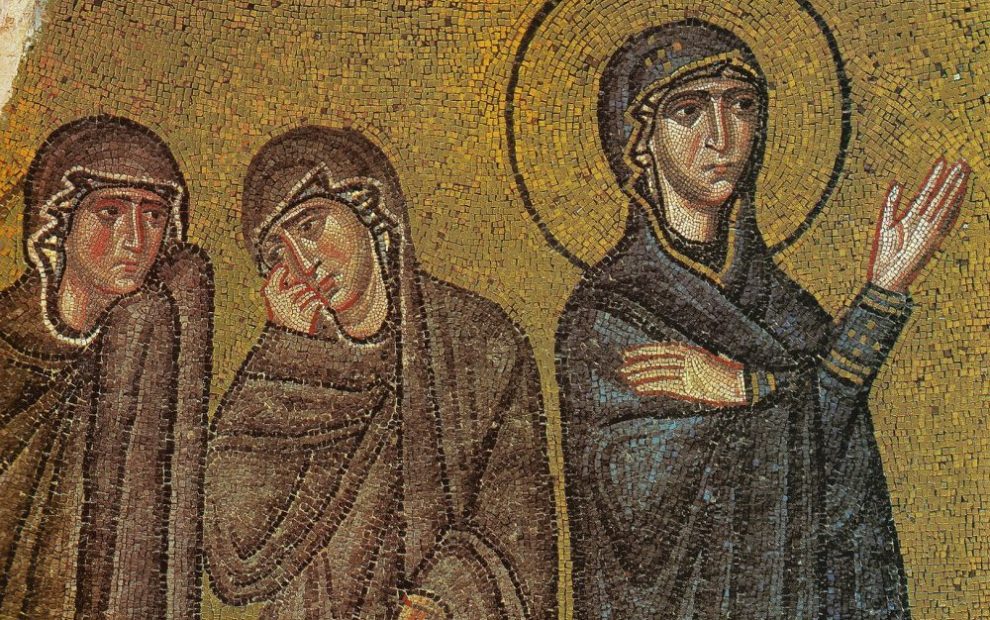It was the day of Preparation, and the Sabbath was beginning. The women who had come with him from Galilee followed, and they saw the tomb and how his body was laid. Then they returned and prepared spices and ointments. On the Sabbath they rested according to the commandment. ––Luke 23:54-56
It was the worst Sabbath any of them could remember.
The Galilean women were far from home, having left their families and all stability to tend to the needs of an itinerant preacher, convinced he would be the anointed political leader to deliver their homeland from a tyrannical occupying power and its dissolute puppet king.
Now, he was dead––murdered in the worst way, executed as the lowest of the low, only spared from rotting on a cross by the occupiers’ wish to avoid unrest over the Passover holiday and the kindness of a rich man they had never met before.
They had not even had time to anoint his body before sundown. They had only had time to scrounge up the costly spices and oils before they retreated into whatever rooms they could find in Jerusalem. These women—perhaps alone, perhaps huddled together—must have stared at those precious vessels through that long, slow Saturday, asking themselves, now that their political and personal hopes were dashed: “Where is God?”
Where is God when we’re the losers?
This question, no doubt asked by the women disciples on that first Holy Saturday, is one we have asked when things go south, personally or professionally. Sometimes we ask it in the face of national or even global crises.
Immigrant populations in fear
This Easter season is one of those times in the United States. Millions around the country––and elsewhere––are in a space of quiet waiting, like the women disciples, wondering when the next bad thing will happen.
America’s immigrant communities—undocumented, documented, or naturalized—face fear and uncertainty. The current administration has deployed Immigration and Customs Enforcement (ICE) agents to detain and intimidate immigrants or those they suspect of being immigrants. Officials may insist that only criminals are being deported, but the facts suggest otherwise.
Fabian Schmidt, a German-born permanent resident with a green card who had lived in the United States since 2007, was detained and held in an ICE detention facility. No charges were filed against him, and his family received no explanation for his arrest. While in custody, Schmidt was violently interrogated, including being stripped and forced into a cold shower..
Kilmar Abrego Garcia, who fled gang persecution and was living and working in the United States legally, was seized in an ICE raid and sent to a for-profit prison in his native country. The White House claims that this was an “administrative error” and has refused to bring Garcia home, even in the face of a U.S. Supreme Court order. Officials have labeled Garcia a gang member, despite no evidence supporting the claim.
The danger to members of immigrant communities does not come solely from the government. Some people have posed as ICE agents in order to scam or intimidate vulnerable people. Recent years have also seen vigilante violence sparked by talk of an “invasion”—such as in Charlottesville, the shooting at the Tree of Life Synagogue, and the mass shooting at an El Paso Walmart.
Intersecting threats
Members of the LGBTQ+ community also dread what comes next—whether that be from the government or vigilantes. Despite only making up 1 percent or less of the U.S. population, trans people have been targeted by 848 bills nationwide so far this year. Among my LGBTQ+ loved ones, many worry that the erasure of their stories from public narratives and the loss of their rights are the prelude to physical harm.
No one is immune to the threat of climate-driven disasters—such as the fires that devastated Los Angeles in January, the flooding that swamped parts of Kentucky, or the ice storms that devastated northern Michigan. People are struggling to survive or rebuild, even as severe cuts are made to the agencies that forecast and respond to disasters.
But cuts to disaster agencies also intersect with immigrant and racial justice issues. For instance, the National Weather Service, a division of NOAA, has ceased translating severe weather alerts—such as tornado warnings—into languages other than English. This is reportedly due to a lapsed translation contract, but it’s hard not to connect it with the recent executive order declaring English the official language of the United States.
Erratic economic policies leave many of the most vulnerable—the unhoused, the elderly, the disabled—in fear. And with the repeated market plunges caused by on-and-off-again tariffs, pointing at a potential recession, even those who are relatively comfortable feel financially insecure. The president’s response? “Only the weak will fail.”
But these issues at home don’t just affect those in the United States. For the most vulnerable abroad, the decimation of the U.S. Agency for International Development (USAID) will be catastrophic. The agency supported critical public health services, including disease detection and treatment, and nutrition assistance. According to an online tracker by public health expert Brooke Nichols, these cuts have already caused thousands of deaths and are likely to lead to millions more before the year ends.
The unseen God
Luke gives only one verse to describe the women’s experience on that Sabbath—obedient restfulness. Yet in the very next verse, perhaps some 36 hours after the crucifixion, everything has changed:
But on the first day of the week, at early dawn, they came to the tomb, taking the spices that they had prepared. They found the stone rolled away from the tomb, but when they went in, they did not find the body. While they were perplexed about this, suddenly two men in dazzling clothes stood beside them. The women were terrified and bowed their faces to the ground, but the men said to them, “Why do you look for the living among the dead? He is not here but has risen (Lk. 24:1-6).
The women prepared their spices Friday evening and set out for the tomb early Sunday. Sometime between those actions, God acted, raising Jesus from the dead, unseen and unanticipated by human beings. As we proclaim at Easter Vigil:
O truly blessed night,
worthy alone to know the time and hour
when Christ rose from the underworld!
God acts in the space between human actions, often in ways beyond our imagination.
The Byzantine icon of the resurrection depicts Holy Saturday and the harrowing of hell rather than Sunday morning and the empty tomb. While his body lies in the tomb, while his disciples have given up all hope, Christ descends in triumph to Hades, shattering its gates and putting death in chains beneath His feet. He raises Adam and Eve, the prototypical humans, from their tombs—not by the hands, but by the wrists, emphasizing that the initiative is all his.
Yet, it was the initiative of the women that led to the discovery of the empty tomb.
Sometimes, action is all we have
The women felt helpless, but still they acted. And right now, millions of people across the country are working to protect human dignity and the fabric of our democracy. Here are just a few examples.
- Some American bishops have remained vocal in their defense of immigrants’ human dignity, the U.S. Conference of Catholic Bishops having sued the administration over refugee resettlement funding and individual bishops publicly protesting the administration’s policies.
- Catholic Charities and Catholic Relief Services continue to serve the vulnerable in and outside the United States, as do scores of other, smaller Catholic relief organizations.
- On April 5, an estimated 3 to 5 million protestors nationwide turned out in opposition to government attacks on immigrants, the LGBTQ+ community, the rule of law, and the social safety net.
- At the time of writing, another protest by the same organizers is scheduled for Holy Saturday, with a goal of 11 million participants. The number corresponds with 3.5 percent of the U.S. population, a percentage social scientists have claimed is necessary to support sustained, nonviolent resistance movements.
On a personal level, I have seen or heard from loved ones of increased participation in community organizations, civic engagement, and perhaps even at the early Mass on Sundays. I have also witnessed individuals’ redoubled private efforts to look out for the ones they love, in whatever way they can.
That was why the women set out early Sunday morning: to do right by one they loved, one last time, without any expectation of good news. During their time of hopelessness, God was at work, though they could not know that yet.
Holy Saturday invites us to honor those times of fear and uncertainty—when we’ve experienced loss and don’t yet know what comes next. But fear and uncertainty need not crush us. Like the women at the tomb, we can choose to act with love and hope, even when the ending is still unknown.
Image: Wikimedia Commons, Icon of the women at the tomb of Jesus












Add comment